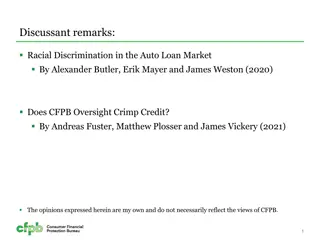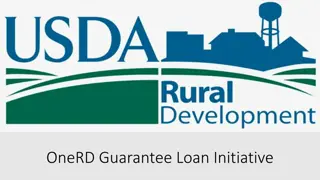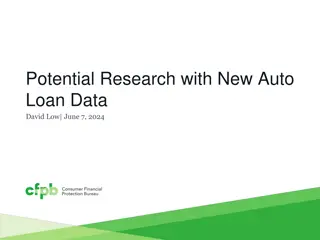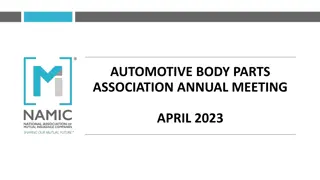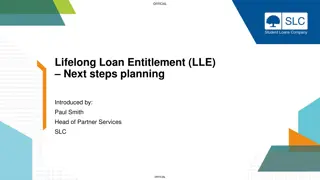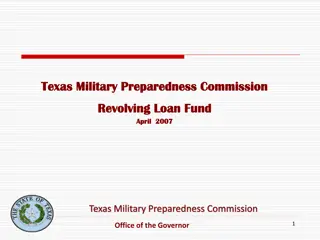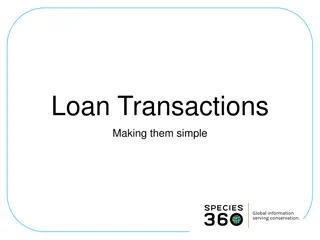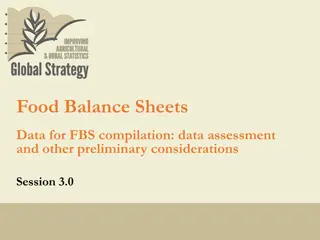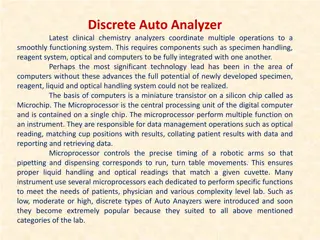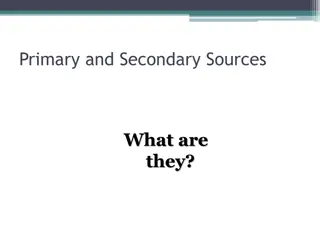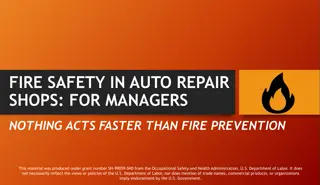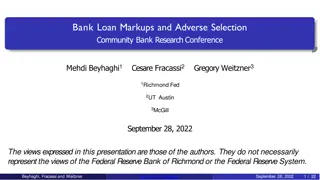Assessment of Available Data Sources in Auto Loan Market
Consumer Financial Protection Bureau's Auto Finance Markets Team explores various data sources for assessing the auto loan market. Examining pros and cons of consumer credit reporting data, call report data, ABS data, and surveys provides insights into market trends, risk analysis, and lender perspectives.
Download Presentation

Please find below an Image/Link to download the presentation.
The content on the website is provided AS IS for your information and personal use only. It may not be sold, licensed, or shared on other websites without obtaining consent from the author. Download presentation by click this link. If you encounter any issues during the download, it is possible that the publisher has removed the file from their server.
E N D
Presentation Transcript
The State of Auto Loan Market Data CFPB Auto Finance Markets Team
Disclaimer This presentation is being made by a Consumer Financial Protection Bureau representative on behalf of the Bureau. It does not constitute legal interpretation, guidance, or advice of the Consumer Financial Protection Bureau. Any opinions or views stated by the presenter are the presenter s own and may not represent the Bureau s views. 2
Consumer Credit Reporting Data Pros Cons Lacks information on collateral, down payment, fees, etc. Relies on information being fully and accurately reported to credit reporting companies Provides loan-level information on origination and performance Contains credit scores, allowing for analysis by risk tier Information furnished directly by the lenders Percent of Subprime Auto Loans Furnished by Lender Type 4
Call Report Data Pros Cons Lacks information for all lenders that do not file call reports, such as finance companies, captives, and buy here pay here lenders Information is provided only at the portfolio level without any levels of granularity Provide quarterly information on overall auto loan and lease portfolios for banks and credit unions 5
ABS Data Pros Cons Provides valuable insight into overall market trends, such as the cost of capital for lenders and APR for borrowers Analysis can be performed based on consumer credit tiers Allows users to see how market participants view the state of the market Limited to publicly traded companies that issue ABS and deals that meet the SEC s reporting threshold. Loans packaged into ABS may be different from loans held by lenders Information available is limited to the needs of investors 6
Surveys Pros Cons Often provides a high level of granularity May provide insight into areas of the market that cannot be seen in other ways Difficult to determine representativeness of data Coverage is often limited to certain geographic areas Potentially expensive to obtain Not all data is reliably updated on set schedule 7
Publicly Available Analysis and Projections Pros Cons Able to provide information on overall trends in the market not found in other data sources Free, open access allows for all market participants to gain insight Often does not provide the ability to dive into deeper levels of granularity Sparsely or inconsistently updated Frequently based on proprietary modeling which cannot be independently verified 8
Examples of Areas in Need of More Data 9
New vs. Used Vehicle Loan Performance Currently loan performance data is not available through any data type that also has information on the vehicle Consumer credit files and ABS data do not have information on the collateral Loan pricing and origination information is available based on the new/used status of the vehicle, but does not have performance metrics
Loan Origination Channel Information on direct vs. indirect auto lending is currently limited Publicly available data estimates 70 80 percent of the auto finance market is indirect Data on how the pricing and performance of these loan channels differ remains opaque
Repossessions No government entity collects data on repossessions Current publicly available data is based on proprietary estimates and does not provide a level of granularity that allows for deeper analysis Credit bureau charge-off indicators have an unknown relationship to repossessions No ability to grasp the prevalence of a variety of repossession methods such as the use of forwarders and technology such as starter-interrupt and GPS devices
Auto Loans and Household Budgets Current view is primarily the loan-to-value ratio included in credit bureau data Datasets do not include verifiable income information for the borrower Prevents analysis of payment-to-income or debt-to-income ratios Limited information on transaction price of vehicle, down payment, collateral, and equity
Discussion Prompts What auto lending data sources do you find valuable? In what areas of the auto lending market do you believe greater visibility and information is needed to help provide insight in market trends? What topics in auto lending have you tried to study, but were unable to fully explore because of a lack of available data or a lack of information? What topics in auto lending would you be interested in analyzing in the future if additional data were to become available? What statistics, data releases, or periodic reports about the auto lending market would be useful for the CFPB to release on an ongoing basis (monthly/quarterly/annually) that would help you in your market monitoring efforts? What do you think is the best way of aggregating and sharing this information? How can the CFPB best provide additional clarity and information on the market?



